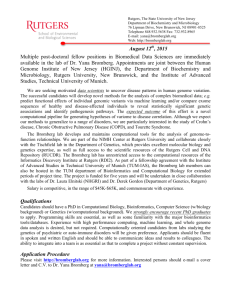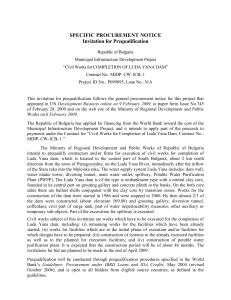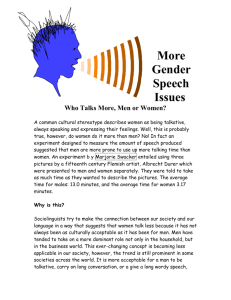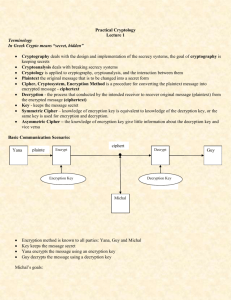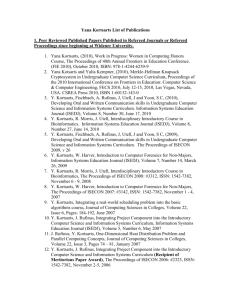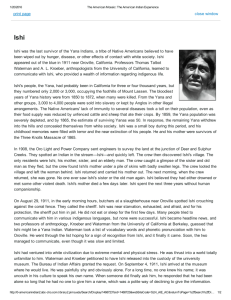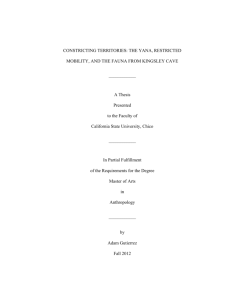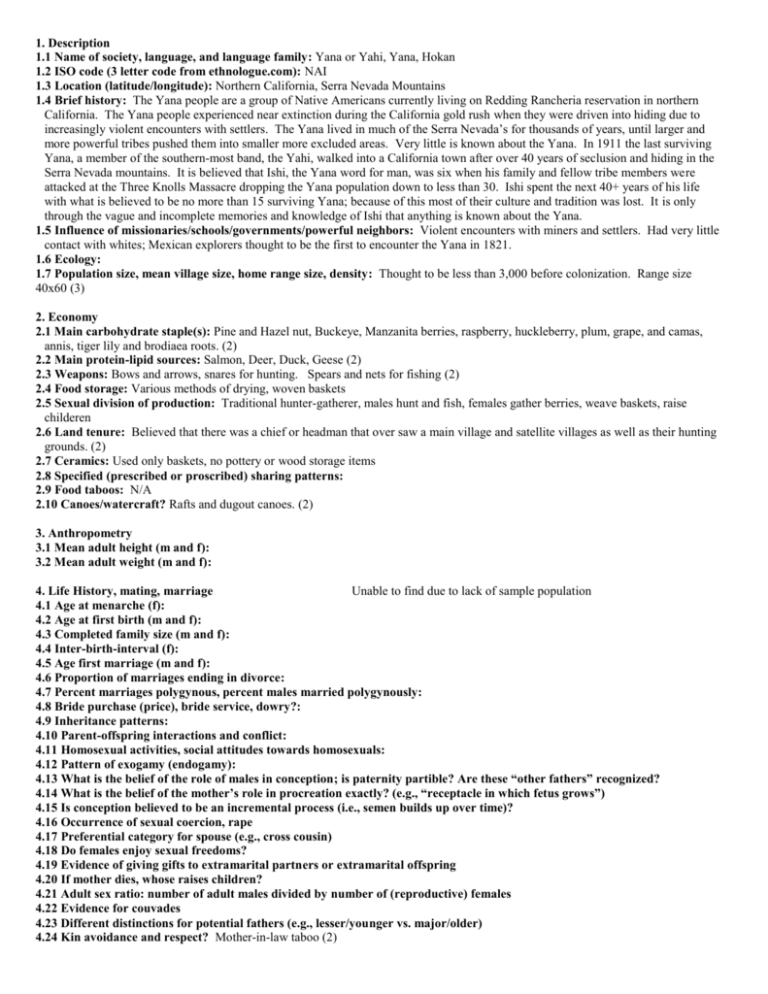
1. Description
1.1 Name of society, language, and language family: Yana or Yahi, Yana, Hokan
1.2 ISO code (3 letter code from ethnologue.com): NAI
1.3 Location (latitude/longitude): Northern California, Serra Nevada Mountains
1.4 Brief history: The Yana people are a group of Native Americans currently living on Redding Rancheria reservation in northern
California. The Yana people experienced near extinction during the California gold rush when they were driven into hiding due to
increasingly violent encounters with settlers. The Yana lived in much of the Serra Nevada’s for thousands of years, until larger and
more powerful tribes pushed them into smaller more excluded areas. Very little is known about the Yana. In 1911 the last surviving
Yana, a member of the southern-most band, the Yahi, walked into a California town after over 40 years of seclusion and hiding in the
Serra Nevada mountains. It is believed that Ishi, the Yana word for man, was six when his family and fellow tribe members were
attacked at the Three Knolls Massacre dropping the Yana population down to less than 30. Ishi spent the next 40+ years of his life
with what is believed to be no more than 15 surviving Yana; because of this most of their culture and tradition was lost. It is only
through the vague and incomplete memories and knowledge of Ishi that anything is known about the Yana.
1.5 Influence of missionaries/schools/governments/powerful neighbors: Violent encounters with miners and settlers. Had very little
contact with whites; Mexican explorers thought to be the first to encounter the Yana in 1821.
1.6 Ecology:
1.7 Population size, mean village size, home range size, density: Thought to be less than 3,000 before colonization. Range size
40x60 (3)
2. Economy
2.1 Main carbohydrate staple(s): Pine and Hazel nut, Buckeye, Manzanita berries, raspberry, huckleberry, plum, grape, and camas,
annis, tiger lily and brodiaea roots. (2)
2.2 Main protein-lipid sources: Salmon, Deer, Duck, Geese (2)
2.3 Weapons: Bows and arrows, snares for hunting. Spears and nets for fishing (2)
2.4 Food storage: Various methods of drying, woven baskets
2.5 Sexual division of production: Traditional hunter-gatherer, males hunt and fish, females gather berries, weave baskets, raise
childeren
2.6 Land tenure: Believed that there was a chief or headman that over saw a main village and satellite villages as well as their hunting
grounds. (2)
2.7 Ceramics: Used only baskets, no pottery or wood storage items
2.8 Specified (prescribed or proscribed) sharing patterns:
2.9 Food taboos: N/A
2.10 Canoes/watercraft? Rafts and dugout canoes. (2)
3. Anthropometry
3.1 Mean adult height (m and f):
3.2 Mean adult weight (m and f):
4. Life History, mating, marriage
Unable to find due to lack of sample population
4.1 Age at menarche (f):
4.2 Age at first birth (m and f):
4.3 Completed family size (m and f):
4.4 Inter-birth-interval (f):
4.5 Age first marriage (m and f):
4.6 Proportion of marriages ending in divorce:
4.7 Percent marriages polygynous, percent males married polygynously:
4.8 Bride purchase (price), bride service, dowry?:
4.9 Inheritance patterns:
4.10 Parent-offspring interactions and conflict:
4.11 Homosexual activities, social attitudes towards homosexuals:
4.12 Pattern of exogamy (endogamy):
4.13 What is the belief of the role of males in conception; is paternity partible? Are these “other fathers” recognized?
4.14 What is the belief of the mother’s role in procreation exactly? (e.g., “receptacle in which fetus grows”)
4.15 Is conception believed to be an incremental process (i.e., semen builds up over time)?
4.16 Occurrence of sexual coercion, rape
4.17 Preferential category for spouse (e.g., cross cousin)
4.18 Do females enjoy sexual freedoms?
4.19 Evidence of giving gifts to extramarital partners or extramarital offspring
4.20 If mother dies, whose raises children?
4.21 Adult sex ratio: number of adult males divided by number of (reproductive) females
4.22 Evidence for couvades
4.23 Different distinctions for potential fathers (e.g., lesser/younger vs. major/older)
4.24 Kin avoidance and respect? Mother-in-law taboo (2)
4.24 Joking relationships?
4.25 Patterns of descent (e.g., bilateral, matrilineal) for certain rights, names or associations
4.26 Incest avoidance rules
4.27 Is there a formal marriage ceremony?
4.28 In what way(s) does one get a name, change their name, and obtain another name?
4.29 Is marriage usually (or preferred to be) within community or outside community? (m/f difference?)
4.30 Are marriages arranged? Who arranges (e.g., parents, close kin)?: Parents arrange marriages for the child. (2)66666rt
4.31 Evidence for conflict of interest over who marries who:
Warfare/homicide
4.14 Percent adult (male) deaths due to warfare:
4.15 Outgroup vs ingroup cause of violent death:
4.16 Reported causes of in-group and out-group killing:
4.17 Number, diversity and relationship with neighboring societies (external relations): Thought to have frequent skirmishes with
neighbors.
4.18 Cannibalism? N/A
5. Socio-Political organization and interaction
5.1 Mean local residential (village) group size: Main village where chief or headman lived, satellite villages nearby. (2)
5.2 Mobility pattern: (seasonality): Stayed within their 40x60 range. Hunting, trapping, and fishing (3)
5.3 Political system: (chiefs, clans etc, wealth or status classes): Believed to have a chief and a ranked or class system (4)
5.4 Post marital residence:
5.5 Territoriality? (defined boundaries, active defense):
5.6 Social interaction divisions ? (age and sex): Strong mother-in-law taboo (2)
5.7 Special friendships/joking relationships:
5.8 Village and house organization: Permanent Multifamily dwellings, temporary hunting shelters, assembly lodge in main village. (2)
5.9 Specialized village structures (mens’ houses): Seasonal homes, earth covered lodges for the winter and thatch dwellings during
the summer. (4)
5.10 Sleep in hammocks or on ground or elsewhere? Slept in structures they built. (4)
5.11 Social organization, clans, moieties, lineages, etc:
5.12 Trade: The Yana trade consisted of furs, salt, and items such as fire making drills, arrows, and shell and stone jewelry. (2)
5.13 Indications of social hierarchies? Unknown, believed to have class or rank system.
6. Ritual/Ceremony/Religion (RCR)
6 Time allocation to RCR: Very little is known about Yana religion. It is believed that they may have practiced the Kuksu. (2)
6.1 Specialization (shamans and medicine): Shamans were generally male and engaged in healing and medicinal practices through
dance and song. (2)
6.2 Stimulants:
6.3 Passage rituals (birth, death, puberty, seasonal): Most Yana dead are cremated. House and belongings also burnt. (2)
6.4 Other rituals:
6.5 Myths (Creation): Very little is known, differs between the four groups. Lizard and Cottontail Rabbit placed sticks on the ground
indicating where they wanted people. (5,74)
6.6 Cultural material (art, music, games):
6.7 Sex differences in RCR:
6.8 Missionary effect: N/A
6.9 RCR revival:
6.10 Death and afterlife beliefs:
6.11 Taboo of naming dead people?
6.12 Is there teknonymy?
6.13 Briefly describe religion (animism, ancestor worship, deism, magic, totems etc.)
7. Adornment (2)
7.1 Body paint: Yes
7.2 Piercings: Both sexes pierced ears
7.3 Haircut: Men plucked facial hair
7.4 Scarification:
7.5 Adornment (beads, feathers, lip plates, etc.): Wealthier individuals had beads and feather bands
7.6 Ceremonial/Ritual adornment:
7.7 Sex differences in adornment: Women wore aporn/skirts made from bark or tule. Men who could afford them wore buck skin
leggings in the winter. Both used hide robes during the winter.
7.8 Missionary effect:
7.9 Cultural revival in adornment:
8. Kinship systems
8.1 Sibling classification system:
8.2 Sororate, levirate:
8.3 Other notable kinship typology, especially cross-cousin (MBD/FZD) typology (Crow/Hawaiian/Omaha etc.):
9. Other interesting cultural features (list them):
The Yana have a division of language for both sexes, men speak one way, women another. (4)
Because of their geographic isolation and separation all four different bands of the Yana tribe spoke with distinctly different dialects and
had uniquely different traditions. (3)
Numbered references
1. Stephen Powers, "Yana and local groups", Overland Monthly Journal, 1875, pg 297-309
2. Barry Pritzker, A Native American Encyclopedia: History, Culture, Peoples, pg 155-156
3. http://www.weareca.org/index.php/en/era/precontact/yana_yahi.html
4. Encyclopedia Britannica: Yana
5. Edward Sapir, Yana Texts, University of California Publications in American Archeology and Ethnology Vol. 9 No. 1, pg. 74,
181, 185

![Edward Sapir [1884-1939] - Frostburg State University](http://s2.studylib.net/store/data/005569801_1-deb1132f1ae8f0e8d561247b81673874-300x300.png)
